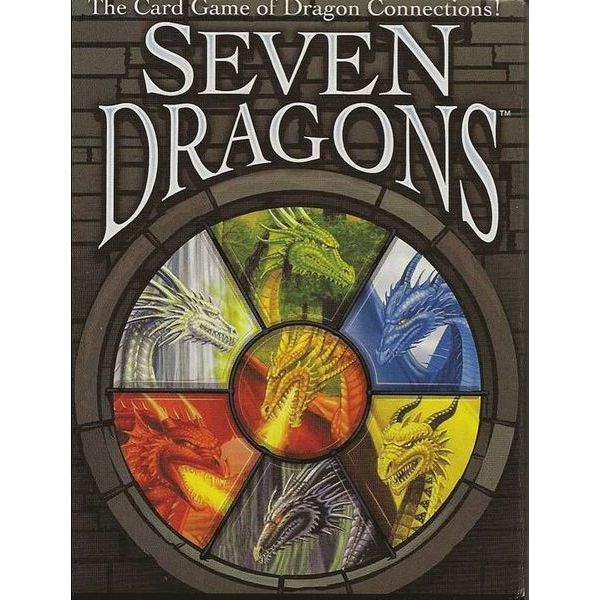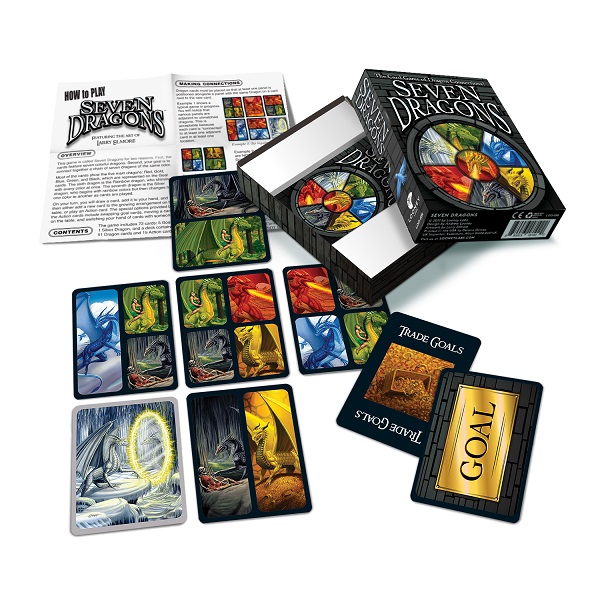Making Colorful Connections in Seven Dragons is Easy: But Can You Make the Right Ones?

In this domino-style game, players take turns adding a dragon card to the tableau, attempting to make a connection of seven dragons in the color they need, while action cards throw an unpredictable element into the mix.
Originally published by Looney Labs back in 2011, Seven Dragons has only recently come out of the company’s vault and been made available again.
Gameplay
The silver dragon card is placed in the center of the table, and each player is dealt a goal card which they keep secret from each other. Each goal card shows one of the game’s five main dragon colors: black, green, gold, red, or blue. The rest of the deck is shuffled and three cards are dealt to each player.
On your turn you draw a card and then play a card. You may either play a dragon or an action card. Dragon cards will either show a single dragon or be divided in up four sections, with each one showing a different colored dragon. When you play a dragon card, it must be placed so that one of the dragons on it is adjacent to a dragon of matching color. You can place the card upside down, but you cannot place it horizontally to the other cards on the table, and it cannot be misaligned from the other cards (for example, you can’t place it so that half of it is hanging below the other cards while the top half is adjacent to a card on the table). The rainbow dragon is a wild and acts as all the colors.
If, when playing a dragon, you match multiple adjacent dragons of different colors, you get to draw extra cards. So, for example, if three of the dragons on the card you play are placed adjacent to dragons whose color matches theirs, then you get to draw two bonus cards.
There are five types of action cards, and each one is associated with a different dragon color. After you play an action, you may choose to place the action card either on top of the discard pile or on the bottom. The silver dragon acts as whatever color matches the action card currently on top of the discard pile. When you play an action card you can also choose to ignore the action. You might do this if you simply wish to change the color of the silver dragon.
Possible actions include trading hands with another player, moving a card on the table to another legal location, trading goal cards (either with a player or with an unused one not dealt out at the start of the game), rotating all goal cards between players, and selecting a card in play and adding it to your hand.
When there is a connecting line of seven dragons of the color that matches your goal card, you win the game.

Review
Seven Dragons is fast and fun, and easy to get sucked into. The rules are simple, without lots of complexity in what is a legal way to place a dragon and what is not; rather, the cards themselves have the dragons divided in several different ways to pose interesting layout options for the players.
You need to watch other players and try to figure out what dragons they might be working towards, keeping an eye on what connections you’re making possible with each card you play, as well as where other people are choosing to put cards.
The fact the silver dragon keeps changing based on the action cards is a clever mechanism that adds another layer to consider when viewing the board, while the actions themselves are quite powerful. While it can be frustrating to have your goal card taken from you, it simply means you have to be extremely careful about not revealing your intentions too early or pushing too quickly towards a particular set of seven. You want to try to be subtle in your plays.
One neat aspect of the game is that, according to the rulebook, as long as the game isn’t full a player can jump in midway through, simply taking one of the unclaimed goal cards. There aren’t many games that allow for this, but it makes sense since action cards will move the goals around and you want to be careful anyway about creating sets of seven matching dragons, even if it’s a color you don’t believe any player is currently working towards.
Since the game has no hand limit, both the card ability that lets you gain a card and the bonus cards you draw from matching multiple dragons, actually means that a player’s hand can grow during the game. This can give you more options as you go on, as well as making the action card that allows you to swap hands with another player more powerful.
The artwork is lovely, with the dragons richly detailed and majestically depicted. There is a lot of empty space on the action cards and goals, however, and the cards are just a little thin. With such lovely artwork, a higher quality card material would have been nice.
Seven Dragons has a lot of clever ideas packed into a light ruleset. There’s plenty of player interaction, the puzzle at its heart is fun, and there’s enough luck to keep things unpredictable.
Pros: Players can join midway through, nice artwork, simple ruleset combined with a good puzzle
Cons: Card quality could be improved
Disclosure: we received a complimentary review copy of this game.







